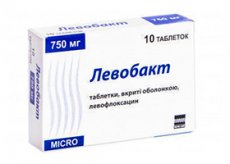Medical expert of the article
New publications
Preparations
Levobactam
Last reviewed: 03.07.2025

All iLive content is medically reviewed or fact checked to ensure as much factual accuracy as possible.
We have strict sourcing guidelines and only link to reputable media sites, academic research institutions and, whenever possible, medically peer reviewed studies. Note that the numbers in parentheses ([1], [2], etc.) are clickable links to these studies.
If you feel that any of our content is inaccurate, out-of-date, or otherwise questionable, please select it and press Ctrl + Enter.

Levobact is an artificial antibacterial drug from the fluoroquinolone category. It has a wide range of antimicrobial activity.
 [ 1 ]
[ 1 ]
Indications Levobacta
It is used to eliminate mild or moderate infections caused by microbes that are sensitive to levofloxacin:
- acute sinusitis;
- exacerbated bronchitis, which has a chronic form;
- community-acquired pneumonia;
- infections with complications that occur in the urinary tract (this includes pyelonephritis );
- infectious lesions of the subcutaneous layer and skin surface.
 [ 2 ]
[ 2 ]
Release form
The medication is produced in tablets of 0.5 or 0.75 g, in the amount of 10 pieces inside a blister pack.
Pharmacodynamics
The drug has a rapid bactericidal effect, which develops by suppressing the bacterial enzyme DNA gyrase, which is part of the structure of type 2 topoisomerases. This leads to the destruction of the bulk DNA chain of microbes and the blocking of their division processes.
The range of activity of the drug includes gram-negative and -positive microorganisms, including non-fermenting microbes, often causing the development of nosocomial infection, and in addition atypical bacteria (chlamydophila pneumoniae, C. trachomatis, and also mycoplasma pneumoniae, ureaplasma and legionella pneumophila). In addition, anaerobes, helicobacter pylori and mycobacteria are sensitive to the drug.
Like other fluoroquinolones, Levobact has no effect on spirochetes.
Pharmacokinetics
The absolute bioavailability of the active ingredient is almost 100%. About 30-40% of the drug is synthesized with blood plasma protein.
After oral administration of the drug in a dose of 0.5 g twice a day, a predictable insignificant accumulation of the active component is observed.
Only a small portion of the substance is metabolized.
Excretion is relatively slow (half-life is 6-8 hours). More than 85% of the dose taken is excreted via the kidneys.
There are no significant differences in the pharmacokinetic parameters of levofloxacin when administered intravenously and orally.
Dosing and administration
The tablets are taken orally, without reference to food intake, but taking into account the severity of the infection and the sensitivity of the causative bacteria. The portion size is 0.25-0.5 g, with one or two times daily use.
The duration of the course is determined by the course of the pathology, but cannot be longer than 2 weeks. The therapy should be continued for at least another 48-72 hours after the temperature has stabilized or the destruction of the causative bacteria has been confirmed by microbiological studies.
The drug is administered intravenously taking into account medical indications:
- for pneumonia - in a serving of 0.5 g twice a day;
- for infections affecting the urinary tract - in a 0.25 g portion once a day;
- for infections affecting subcutaneous tissues and the skin surface - at a dosage of 0.25 g twice a day.
Because the drug is excreted in the urine, people with renal insufficiency need to adjust the dosage depending on the level of CC.
Use Levobacta during pregnancy
Levobact should not be prescribed to pregnant women.
Side effects Levobacta
The use of the drug often leads to the appearance of such side effects:
- signs of hypersensitivity, hyperemia and pain at the injection site, as well as phlebitis (during intravenous infusion);
- diarrhea and nausea;
- feeling of drowsiness and headaches;
- tachycardia
- increase in the activity of the elements ALT and AST in the blood plasma;
- leukopenia or eosinophilia.
The following symptoms appear quite rarely:
- photosensitivity and bronchospasm;
- a sharp decrease in blood pressure values (with intravenous injections);
- development of hypoglycemia;
- the appearance of paresthesia;
- the emergence of psychosis;
- development of tubulointerstitial nephritis or hepatitis, as well as pseudomembranous colitis, manifested in the form of bloody diarrhea;
- agranulocytosis or thrombocytopenia.
Overdose
In cases of intoxication, the most common manifestations that develop are those affecting the function of the central nervous system, such as dizziness, a feeling of confusion, psychosis, and seizures.
Symptomatic measures are used to eliminate the disorders. The dialysis procedure does not promote the excretion of levofloxacin. The drug has no antidote.
Interactions with other drugs
The absorption of levofloxacin is significantly weakened when used in combination with magnesium- or aluminum-containing antacids, as well as with drugs containing iron salts.
It is necessary to combine Levobact with caution with medications that lower the seizure threshold (such as NSAIDs and theophylline).
Cimetidine with probenecid weakens the elimination of the drug from the body.
Storage conditions
Levobact must be kept in a place protected from moisture. Temperature – no higher than 25°C.
Shelf life
Levobact can be used for 3 years from the date of release of the drug.
Application for children
The medicine is not used by persons under 18 years of age.
Analogues
Analogues of the drug include such drugs as Lefloq, Levomak (also administered intravenously), Levolet, Leflocin with Levofloxacin-Zdorovye, as well as Flexid with Floxium and Tavanic.
Attention!
To simplify the perception of information, this instruction for use of the drug "Levobactam" translated and presented in a special form on the basis of the official instructions for medical use of the drug. Before use read the annotation that came directly to medicines.
Description provided for informational purposes and is not a guide to self-healing. The need for this drug, the purpose of the treatment regimen, methods and dose of the drug is determined solely by the attending physician. Self-medication is dangerous for your health.

